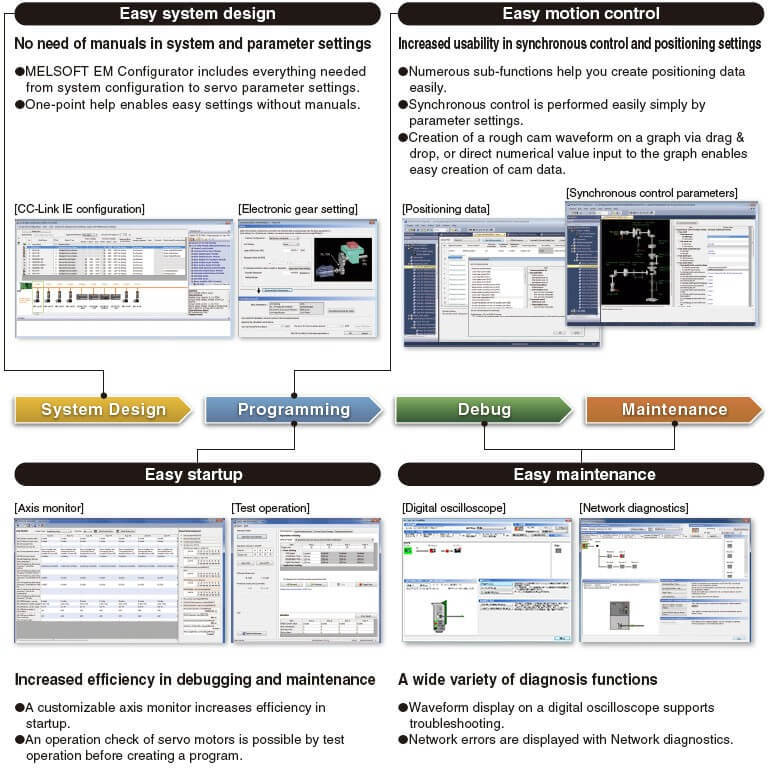Motion Controllers
EMBEDDED TYPE SERVO SYSTEM CONTROLLER
การควบคุมเซอร์โวเฉพาะที่สามารถทำได้ผ่านการเขียนโปรแกรมภาษา C
การควบคุมเซอร์โวที่มีการตอบสนองสูงสามารถใช้ร่วมกับตัวควบคุม C และโมดูลอินเทอร์เฟซ หรือคอมพิวเตอร์ส่วนบุคคลและบอร์ดตำแหน่ง
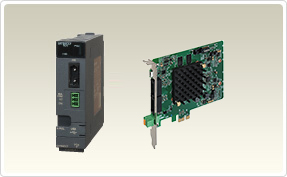
Speed-Torque Control
Speed
control follows speed commands to keep the speed constant, and torque control
follows torque commands to keep the torque constant.
The Simple Motion board can be used for the speed-torque control, such as
unwinding or rewinding.
Positioning using absolute position coordinates can be smoothly performed even
after switching back to position control because the current position is
controlled during the speed-torque control.
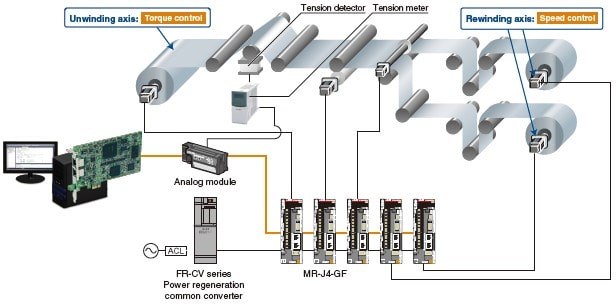
The Simple Motion board can be used for the speed-torque control, such as unwinding or rewinding.
Positioning using absolute position coordinates can be smoothly performed even after switching back to position control because the current position is controlled during the speed-torque control.

Advanced Synchronous Control
The advanced synchronous control
is software-based synchronous control as an alternative to mechanical control,
such as gear, shaft, clutch, speed change gear, and cam. In addition, a cam is
easily generated with cam auto-generation function. The synchronous control can
be started and ended for each axis, allowing the synchronous control axis and
positioning control axis within the same program.
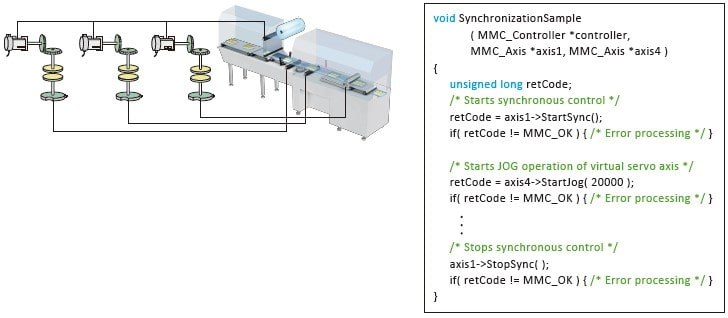
Cam auto-generation
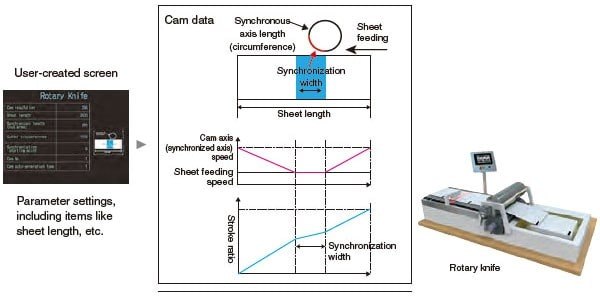
Cam data for a rotary cutter can
be generated automatically simply by parameter settings of sheet length,
synchronization width, cam resolution, etc.


Direct
control 
The direct control is a function
that controls servo amplifiers directly by transmitting set command positions
for each operation cycle from a user program to the servo amplifiers.
·
The direct control can be combined with positioning control.
·
Control can be switched between the direct control and the
positioning control.
·
A personal computer with a real-time operating system can
perform fixed-cycle Motion control using interrupts at every operation cycle.
· Thanks to the position command buffers of up to 16 phases, even non-real-time operating system (Windows® ) can perform at 0.5 ms (the fastest rate) cycle command operation; This enables further increase in accuracy in trajectory control.
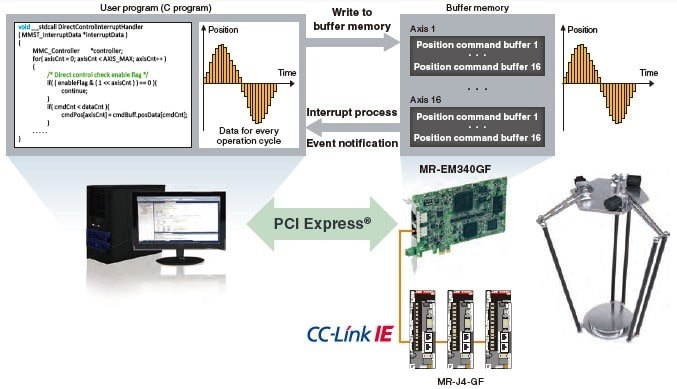
(Note): Execute coordinate conversion of a parallel link robot with a user program.
Event history 
Events occurred on each slave device and servo amplifiers can be stored to the Simple Motion board. Information of "WRITE" operation to the program, error occurrence, etc. is listed chronologically, enabling an investigation of the cause of the error and a prompt restoration of servo amplifiers.
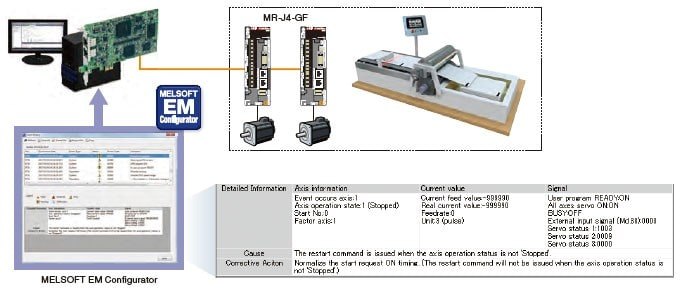
Software Development Kit MELSOFT EM Software Development Kit
MELSOFT EM Software Development Kit is a development software package, supporting the engineering process from system design and programming to debug and maintenance for the Simple Motion board.
 MELSOFT EM Configurator - Every step in the engineering process from system design
and programming to debug and maintenance, is supported by this software.
MELSOFT EM Configurator - Every step in the engineering process from system design
and programming to debug and maintenance, is supported by this software.
 MELSOFT MR Configurator2 - Primarily, tuning, monitoring, and diagnosis are easily
performed with this software by being connected to a servo amplifier.
MELSOFT MR Configurator2 - Primarily, tuning, monitoring, and diagnosis are easily
performed with this software by being connected to a servo amplifier.
 API library - The API library is an add-on library which uses functions
(method) and labels (member) of controller and axis classes, and enables easy
programming with Visual C++®.
API library - The API library is an add-on library which uses functions
(method) and labels (member) of controller and axis classes, and enables easy
programming with Visual C++®.
 PCI Express® device driver - The PCI
Express® device driver is software for a user program to gain
access to the Simple Motion board via PCI Express®.
PCI Express® device driver - The PCI
Express® device driver is software for a user program to gain
access to the Simple Motion board via PCI Express®.
(Note): Contact
your local sales office for the latest version of Software Development Kit.
Development and Debugging Environments
A user
program is created by adding the API library (for motion control) to a project
of Microsoft Visual Studio®.
● INtime® and RTX (real-time operating system) are supported.
(Note):
Contact your local Mitsubishi Electric office for more details.
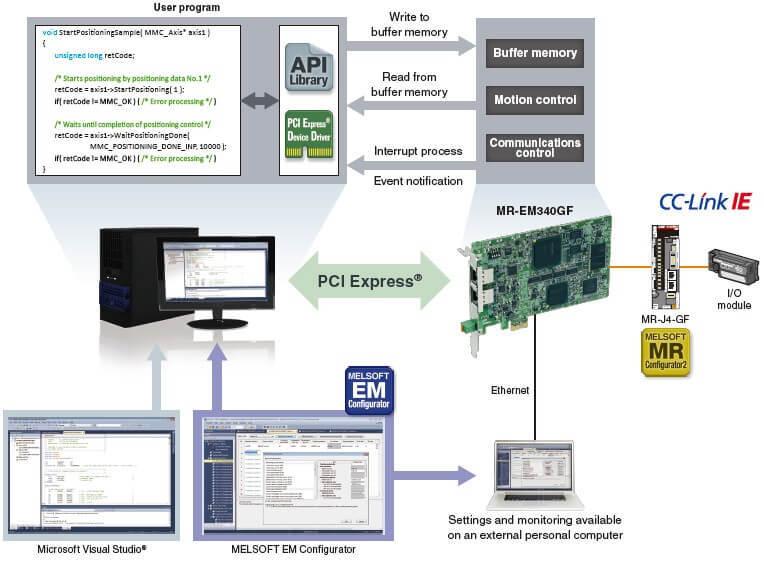
(Note): OS and the development environment are not included.
● INtime® and RTX (real-time operating system) are supported.

 MELSOFT EM
Configurator (Setting Tool for Simple Motion Board)
MELSOFT EM
Configurator (Setting Tool for Simple Motion Board)
 API library (C++
motion class library)
API library (C++
motion class library)
With the C++ motion class
library, a program is created using functions (method) and labels (member) of
controller and axis classes, and other classes.
·
The class library creates the program with high readability.
·
Coding time is reduced with Microsoft Visual Studio® IntelliSense®.
·
Compatibility with event-driven programming is improved by
specifying any bit data as a condition of interruption.
·
The library with the same interface specifications as PLCopen® Motion
Control FB, is available and suitable for fixed-cycle programming.
[Conception
diagram of class types in C++ motion class library]
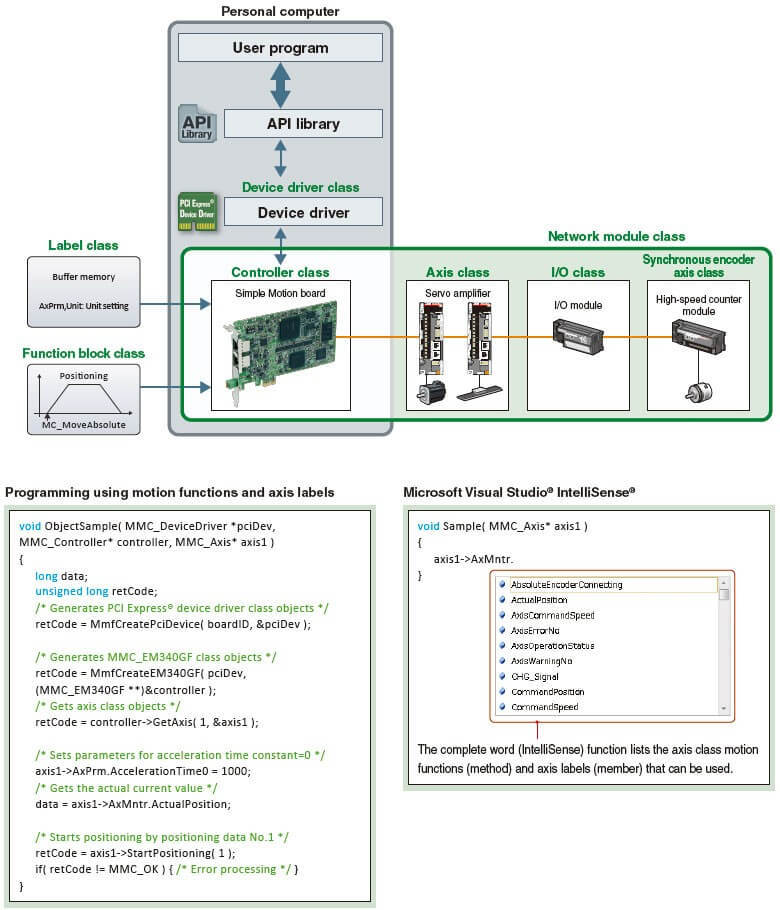

CC-Link IE Field Network Servo Amplifier MR-J4-GF
CC-Link IE Field Network servo
amplifiers achieve an optimal solution and improve productivity in combination
with the Simple Motion board.
·
Industry-leading basic performance
Industry-leading levels of servo amplifier basic performance shorten a machine
cycle time.
·
Advanced servo gain adjustment
The advanced vibration suppression control function is easily used for
maximizing your machine performance.
·
A wide range of product series and capacities
From rotary to linear and direct drive motors, a wide range of servo motors are
available, significantly improving your machine performance.
·
Preventive maintenance
The data inside a servo amplifier are read via the network, and used for
preventive maintenance, such as machine diagnostics.
Industry-leading levels of servo amplifier basic performance shorten a machine cycle time.
The advanced vibration suppression control function is easily used for maximizing your machine performance.
From rotary to linear and direct drive motors, a wide range of servo motors are available, significantly improving your machine performance.
The data inside a servo amplifier are read via the network, and used for preventive maintenance, such as machine diagnostics.
Control mode
Two types of modes are available
according to your needs:
·
Motion mode for a wide range of motion control functions, such
as multiple-axis positioning, synchronous control, etc.
·
I/O mode for single-axis positioning
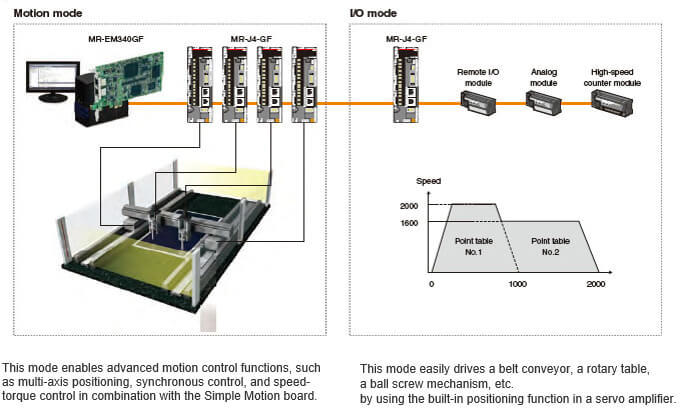
C Controller Interface module
โมดูลอินเทอร์เฟซของตัวควบคุม C จะกำหนดค่าระบบเซอร์โวที่มีการตอบสนองสูงร่วมกับตัวควบคุม C
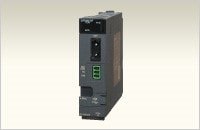
Position board
ฝังใน PC บอร์ดตำแหน่งจะกำหนดค่าระบบเซอร์โวที่มีการตอบสนองสูง
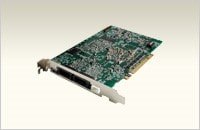
Functions List
| Simple Motion board | ||||
|---|---|---|---|---|
| MR-EM340GF | ||||
| Maximum number of control axes (virtual servo amplifier axis included) | 16 axes | |||
| Servo amplifier connection system | CC-Link IE Field Network | |||
| Maximum distance between stations [m(ft.)] | 100(328.08) | |||
| Connectable servo amplifier | MR-J4-GF , MR-J4-GF-RJ | |||
| Operation cycle (operation cycle settings) | 0.5 ms, 1.0 ms, 2.0 ms, 4.0 ms | |||
| Engineering Environment | MELSOFT EM Software Development Kit | |||
| Control modes | Positioning, Trajectory control (linear, arc, and helical), Speed control, Speed-torque control | |||
| Control unit | mm, inch, degree, pulse | |||
| Number of positioning data | 600 data/axis | |||
| Acceleration/deceleration process | Trapezoidal acceleration/deceleration, S-curve acceleration/deceleration | |||
| Manual control | JOG operation, Manual pulse generator, Inching operation | |||
| Expansion control | Direct control | |||
| Functions that change control details | Current value change, Target position change function, Torque change function, Speed change function, Override function, Acceleration/deceleration time change function | |||
| Home position return method | Driver home position return method | |||
| Auxiliary functions | Forced stop function, Hardware stroke limit function, Software stroke limit function, Absolute position system, Amplifier-less operation function, Unlimited length feed, Optional data monitor function, Mark detection function, Flash ROM backup, M-code output function, Event history function, Digital oscilloscope function, Cam auto-generation function | |||
| Number of occupied I/O points | 32 points (I/O allocation: Intelligent function module, 32 points) | |||
| Current consumption [A] | 12 VDC | 0.4 | ||
| 3.3 VDC | 0.6 | |||
| Mass [kg] | 0.13 | |||
Performance specifications of CC-Link IE Field Network
| Simple Motion module | |||
|---|---|---|---|
| MR-EM340GF | |||
| Maximum link points per network | RX | 16k points (16384 points, 2 kbytes) | |
| RY | 16k points (16384 points, 2 kbytes) | ||
| RWr | 8k points (8192 points, 16 kbytes) | ||
| RWw | 8k points (8192 points, 16 kbytes) | ||
| Maximum link points per station | Master station | RX | 16k points (16384 points, 2 kbytes) |
| RY | 16k points (16384 points, 2 kbytes) | ||
| RWr | 8k points (8192 points, 16 kbytes) | ||
| RWw | 8k points (8192 points, 16 kbytes) | ||
| Local station | RX | 2k points (2048 points, 256 bytes) | |
| RY | 2k points (2048 points, 256 bytes) | ||
| RWr | 256 points, 512 bytes | ||
| RWw | 256 points, 512 bytes | ||
| Intelligent device station | RX | 2k points (2048 points, 256 bytes | |
| RY | 2k points (2048 points, 256 bytes | ||
| RWr | 256 points, 512 bytes | ||
| RWw | 256 points, 512 bytes | ||
| Remote device station | RX | 128 points, 16 bytes | |
| RY | 128 points, 16 bytes | ||
| RWr | 64 points, 128 bytes | ||
| RWw | 64 points, 128 bytes | ||
| Ethernet | Communication speed | 1Gbps | |
| Connection cable | 1000BASE-T Ethernet cable (Note-1): category 5e or higher (double shielded/STP) straight cable | ||
| Maximum distance between stations [m(ft.)] | 100(328.08) (conforms to ANSI/TIA/EIA-568-B (category 5e)) | ||
| Topology | Line type, star type, line/star mixed type | ||
| Overall cable distance | Line type [m(ft.)] | 12000(39370.08) (When 1 master station and 120 slave stations are connected) | |
| Star type(Note-2) | Depends on system configuration | ||
| Maximum connectable stations per network | 121 stations (1 master station. 120 slave stations) | ||
| Maximum number of networks | 239 | ||
(Note-1): Use the cables recommended by CC-Link Partner Association for CC-Link IE Field Network.
CC-Link IE Controller Network cables are not compatible with CC-Link IE Field Network.
(Note-2): A switching hub is required for star topology.
